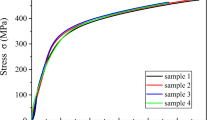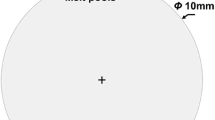Abstract
Compacted graphite iron (CGI) plays a key role in engine reliability and achieving high emission standards. However, it is a difficult-to-machine material. The main reason for tool breakage in high-speed milling compacted graphite iron (CGI) is related to the thermal crack of tool caused by thermal load. The three-dimensional transient thermal stress field model of tool for high-speed milling CGI was established for the first time, and the thermal crack initiation region of tool during high-speed milling CGI was predicted based on this model; it was predicted that the areas prone to initiate thermal cracks were 0 ≤ X ≤ 0.09 mm, 0 ≤ Y ≤ 0.27 mm, and 0.25 ≤ Z ≤ 2.05 mm. The temperature variation of cemented carbide tool in symmetrical end-face milling was simulated by using high-power laser simulation experiment. The heating time and cooling time of laser heating tool were determined according to the actual cutting process, which were the same as the cutting time and non-cutting time in actual milling, and the number of thermal shocks during heating was the same as that of tool failure in actual milling. The macro lens of the infrared thermal imager was used to measure the temperature, and the temperature required for the experiment was obtained by adjusting the laser power. The method of predicting the thermal crack initiation region of tool for high-speed milling CGI has important theoretical significance for the directional precise design of tools efficiently.









Similar content being viewed by others
Data availability
The data sets supporting the results of this article are included within the article.
Code availability
Not applicable.
References
Zou CL, Pang JC, Qiu Y, Liu R, Li SX, Jing GX, Xu CG, Zhang ZF (2022) The high-cycle fatigue fracture mechanism and fatigue strength prediction of compacted graphite iron. Int J Fatigue 161:106881. https://doi.org/10.1016/j.ijfatigue.2022.106881
Essam MA, Shash AY, Megahed H, El-Kashif E (2021) Effect of section thickness on microstructure and mechanical properties of compacted graphite iron for diesel engine applications. Heliyon 7:e05930. https://doi.org/10.1016/j.heliyon.2021.e05930
Shi GQ, Yang Z, Li JP, Tao D, Ma ZJ (2020) Investigation on the graphite nucleation and growth mechanism of the compacted graphite iron. J Mater Res Technol 9:8186–8196. https://doi.org/10.1016/j.jmrt.2020.05.051
Xu LH, Huang CZ, Li CW, Wang J, Liu HL, Wang XD (2021) Estimation of tool wear and optimization of cutting parameters based on novel ANFIS-PSO method toward intelligent machining. J Intell Manuf 32:77–90. https://doi.org/10.1007/s10845-020-01559-0
Chen L, Liu L, Guo H (2018) Study on parameter optimization and tool wear of milling compacted graphite iron RuT450 cylinder block. Key Eng Mater 764:351–360. https://doi.org/10.4028/www.scientific.net/KEM.764.351
Rosa SN, Diniz AE, Andrade CLF, Guesser WL (2010) Analysis of tool wear, surface roughness and cutting power in the turning process of compact graphite irons with different titanium content. J Braz Soc Mech Sci 32:234–240. https://doi.org/10.1590/S1678-58782010000300006
Sander G, Anselmo ED, Cássio LFA, Wilson LG (2010) Performance of carbide and ceramic tools in the milling of compact graphite iron-CGI. J Braz Soc Mech Sci 5:511–517. https://doi.org/10.1590/S1678-58782010000500011
Su R, Huang CZ, Xu LH, Zou B, Liu HL, Liu Y, Li CW (2018) Research on the serrated chip in the milling of compacted graphite iron by cemented carbide tool. Int J Adv Manuf Tech 99:1687–1698. https://doi.org/10.1007/s00170-018-2439-2
Niu J, Huang C, Li CW, Zou B, Xu LH, Wang J, Liu ZQ (2020) A comprehensive method for selecting cutting tool materials. Int J Adv Manuf Tech 110:229–240. https://doi.org/10.1007/s00170-020-05534-0
Xu LH, Huang CZ, Li CW, Wang J, Liu HL, Wang XD (2021) An improved case based reasoning method and its application in estimation of surface quality toward intelligent machining. J Intell Manuf 32:313–327. https://doi.org/10.1007/s10845-020-01573-2
Su R, Huang CZ, Zou B, Liu GL, Liu ZQ, Liu Y, Li CW (2018) Study on cutting burr and tool failure during high-speed milling of compacted graphite iron by the coated carbide tool. Int J Adv Manuf Tech 98:201–211. https://doi.org/10.1007/s00170-017-1573-6
Peng RT, Tong JW, Tang XZ, Chen R, Jiang SQ (2020) Crack propagation and wear estimation of ceramic tool in cutting inconel 718 based on discrete element method. Tribol Int 142:105998. https://doi.org/10.1016/j.triboint.2019.105998
Wang F, Ma YE, Guo YN, Huang W (2020) Study on thermally induced crack propagation behavior of functionally graded materials using a modified peridynamic model. Adv Mater Sci Eng 2020:1317965. https://doi.org/10.1155/2020/1317965
Tan Y, Yang D, Sheng Y (2008) Discrete element method (DEM) modeling of fracture and damage in the machining process of polycrystalline SiC. J Eur Ceram Soc 29:1029–1037. https://doi.org/10.1016/j.jeurceramsoc.2008.07.060
Guo CF, Dong Z (2019) The super-hard cutting tools’ thermal-cracks monitoring system based on multi-agent technologies. MSEE 2019, 2020 IOP Conference Series-Materials Science and Engineering, 735, 012046. Nov. 2019, Wuhan, Hubei, China.https://doi.org/10.1088/1757-899X/735/1/012046
Nazari MB, Rokhi MM (2020) Evaluation of SIFs for cracks under thermal impact based on Green-Naghdi theory. Theor Appl Fract Mec 107:102557. https://doi.org/10.1016/j.tafmec.2020.102557
Zhao B, Zhao XX, Lin LL, Zou LL (2020) Effect of bias voltage on mechanical properties, milling performance and thermal crack propagation of cathodic arc ion -plated TiAlN coatings. Thin Solid Films 708:138116. https://doi.org/10.1016/j.tsf.2020.138116
Lu Y, Ripplinger K, Huang XJ, Mao Y, Detwiler D, Luo AA (2019) A new fatigue life model for thermally-induced cracking in H13 steel dies for die casting. J Mater Process Tech 271:444–454. https://doi.org/10.1016/j.jmatprotec.2019.04.023
Wang Z, Li P (2015) Dynamic failure and fracture mechanism in alumina ceramics: experimental observations and finite element modelling. Ceram Int 41:12763–12772. https://doi.org/10.1016/j.ceramint.2015.06.110
Anderson TL (2004) Fracture mechanics: fundamentals and applications, 3rd edn. CRC Press, Florida
Wang LM, Liu HL, Huang CZ, Niu JH, Liu XF, Yao P (2021) Three-dimensional transient cutting tool temperature field model based on periodic heat transfer for high-speed milling of compacted graphite iron. J Clean Prod 322:129106. https://doi.org/10.1016/j.jclepro.2021.129106
Boston OW, Gillbert WW (1947) Influence on tool life and power of nose radius, charmfer, and peripheral cutting edge angle when face milling a 40000 psi cast iron. Trans ASME 69:117–124
Zorev NN (1963) Machine steel with a carbide- tripped tool in interrupted heavy- cutting conditions. Russian Eng J 43:43–47
Braiden PM, Dugdale DS (1970) Failure of carbide tools in intermittent cutting. Proc Conf on Materials for Metal Cutting, Page iron and steel instp, Scarborough, p 30
Huang CZ (1994) Development of new multiphase ceramic tool materials and cutting reliability research. Doctoral Dissertation of Shandong University of Technology, Jinan, pp 152–153 (in Chinese)
Funding
This work was supported by National Natural Science Foundation of China [52075300, 52275464]; Scientific Research Project for National High-level Innovative Talents of Hebei Province Full-time Introduction [2021HBQZYCXY004]; Natural Science Foundation of Shandong Province [ZR2022ZD08].
Author information
Authors and Affiliations
Contributions
Limei Wang: conceptualization, methodology, investigation, formal analysis, writing—original draft, writing—review and editing. Hanlian Liu: methodology, investigation, formal analysis, supervision, writing—review and editing. Chuanzhen Huang: formal analysis, supervision, writing—review and editing. Yulan Yuan: investigation, writing—review and editing. Yao Peng: formal analysis, supervision. Jun Huang: formal analysis, writing—review and editing. Quanquan Han: formal analysis.
Corresponding authors
Ethics declarations
Ethics approval
Not applicable.
Consent to participate
Not applicable.
Consent for publication
The authors confirm that the publication of the paper has been approved by all co-authors.
Competing interests
The authors declare no competing interests.
Additional information
Publisher's note
Springer Nature remains neutral with regard to jurisdictional claims in published maps and institutional affiliations.
Rights and permissions
Springer Nature or its licensor (e.g. a society or other partner) holds exclusive rights to this article under a publishing agreement with the author(s) or other rightsholder(s); author self-archiving of the accepted manuscript version of this article is solely governed by the terms of such publishing agreement and applicable law.
About this article
Cite this article
Wang, L., Liu, H., Huang, C. et al. A methodology to predict thermal crack initiation region of tool for high-speed milling compacted graphite iron based on three-dimensional transient thermal stress field model. Int J Adv Manuf Technol 125, 2065–2075 (2023). https://doi.org/10.1007/s00170-023-10832-4
Received:
Accepted:
Published:
Issue Date:
DOI: https://doi.org/10.1007/s00170-023-10832-4




